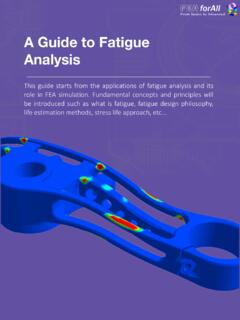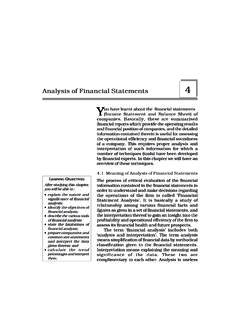Transcription of A Guide to Thermal Analysis - FEA for All
1 A Guide to Thermal AnalysisThis Guide starts from applications of Thermal Analysis and its role in simulation driven design. Fundamental concepts and principles will be introduced such as conduction, convection, radiation, linear and nonlinear heat transfer, steady state and transient Analysis , etc. Finally we will discuss how to choose appropriate finite element Analysis software for Thermal Analysis ; and introduce strength of midasNFX for solving Thermal 3 Efficiency and innovation are contradictory challenges in the sector of product development, and both them must be satisfied in modern companies that strive to remain competitive.
2 Simulation driven design process was introduced and has largely replaced the traditional prototyping-testing process in the last decade. Companies can benefit from the cost and time efficiency of design verification tools based on finite element methods, and concentrate main efforts on product : $ $ $ $Traditional Product Design ProcessSimulation Driven Design ProcessCAD SimulationExperienceComputerOptimization Prototyping1 PrototypeTestingManyTestsTest1 TestProductionCost: $ Thermal Analysis for Analysis Driven Design By introducing computer aided design verification tools in the early stage of the product design.
3 Time and cost wasted in the prototype -test -redesign cycle are significantly 1 Page 3 Thermal related problems are challenges commonly faced by product design engineers. Some of the problems include overheating, excessive Thermal stresses, Thermal effect on dimensional stability, etc. Following are some applications in which Thermal factors need to be Analysis ApplicationElectronics product designThermal problems are commonly encountered in electronic product design. In design of conventional parts, such as heat sinks and cooling fans, adequate heat needs to be removed, as well as keeping the parts small the heat sink application, by performing Thermal Analysis on the design model, engineer easily spotted overheated area on the MOSFET, and made appropriate modification to improve the cooling performance of the heat the verification -redesign iterations were done in the early stage of the design without having to manufacture any costly physical prototype.
4 Product failure was prevented, meanwhile time and cost were Temp : 176 CMax. Temp : 132 C<Current Design> <Improved Design>NFX ApplicationCooling performance improvement of MOSFET heat sinkTraditional machine designThermal problems are also to be considered in traditional machine design. In design of engines, pumps, hydraulic cylinders, excessive temperature and Thermal stress are to be prevented to ensure the machine performance. And for processing machines where mechanical precision is important, the effect of Thermal expansion need to be considered.
5 PositionTemperature<Original>Temperature<Improved >7310 C6309 CHousing CBearing area From Cto C( decreases)NFX ApplicationDesign of cooling fins for high temperature / high tension pumpFigure 2 Figure 3In the application above, cooling fins were designed to prevent overheating of a pump which operates under high temperature and high pressure 3 Automotive parts designSame as machines, design of automotive parts and components also need to consider overheating and excessive Thermal stress problems.
6 Thermal performances of motors, brakes, hydraulic pumps are to be evaluated during the design the right application, Thermal Analysis was performed to choose the appropriate type of brake fluid. The maximum temperature transferred to brake fluid was predicted using heat transfer Analysis . And the boiling point of the chosen brake fluid needs to be higher to avoid the vapor lock ( C)Time (s) fluid temperature as per timeNFX ApplicationBrake fluid temperature analysisFrom structural Analysis to Thermal analysisUsing computer aided design verification tools to validate structural design is already a common practice among design engineers.
7 It is very easy to expand the knowledge of structural Analysis to Thermal Analysis because they are based on the same concept and follow the same Analysis FundamentalsStructural Analysis Thermal AnalysisLoad:Axial force per unit lengthInternal heat generation per unit length Boundary: Constraint conditionor forced displacementSpecified temperatureDisplacementTemperatureStrain Temperature GradientStressHeat FluxTemperatureTemperature GradientStructural Analysis and Thermal Analysis ComparisonFigure 4 Figure 5 Figure 6 Thermal Analysis OutputAs illustrated in figure 5 -6, Thermal Analysis are usually performed to find the temperature distribution, temperature gradient and heat flux of the target model.
8 The simulation approach is particularly beneficial for solving Thermal problems because firstly you can use the same CAD model to perform Thermal Analysis as well as structural Analysis . Secondly measuring temperatures and temperature changes can be very difficult in a real test, especially when temperatures inside small parts and assemblies are to be transfer mechanismHeat transfer Analysis is the most common Thermal Analysis , it analyzes the heat flow due to temperature differences and the subsequent temperature distribution and changes.
9 3 heat transfer methods include conduction, convection and radiationMechanismMain CharacteristicsConductionResponsible for heat flow inside a solid bodyConvectionResponsible for heat entering and escaping a solid bodyHeat Transfer by convection requires the solid body to be surrounded by a fluid like air, water,oil for heat entering and escaping a solid bodyHeat Transfer byradiation is always present but becomes noticeable only at higher temperaturesFigure 7 ConductionConduction describes heat flowing inside a body.
10 Heat energy is transferred through the chained vibration of molecules or neutrons from high temperature region to low temperature Transfer FundamentalsTHOTTCOLDLK: Thermal conductivityA: Area of the wallL: Wall ThicknessMetals (conductor) K~10 -1000 (Insulators) K~ -1 8 Regardless of the state of a material such as solid, liquid or gas, conduction always occurs if a temperature difference (temperature gradient) exists within the object. Moreover, Thermal energy moves from the high-temperature region to a low-temperature simple example in figure 9 demonstrates typical Analysis result of conduction in heat conduction of a simple plateFigure 9100 C20 CConvectionConvection describes the mechanism of heat exchange between an external face of a solid body and the surrounding fluid such as air, steam, water, oil, etc.





